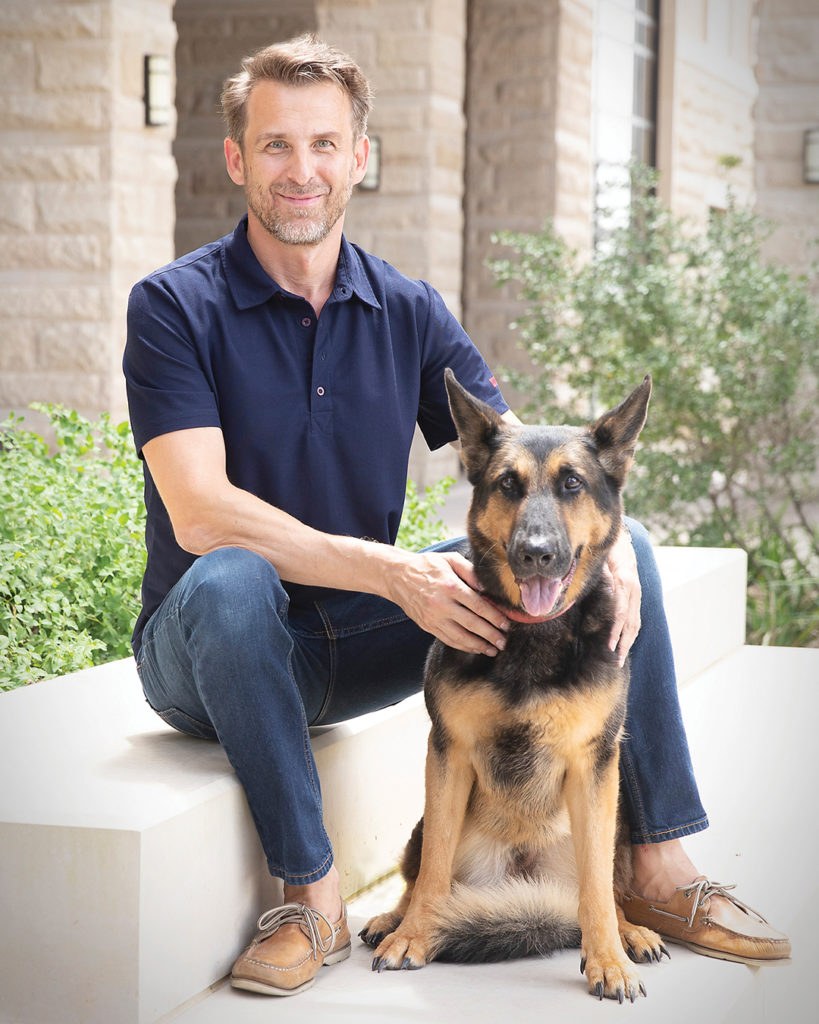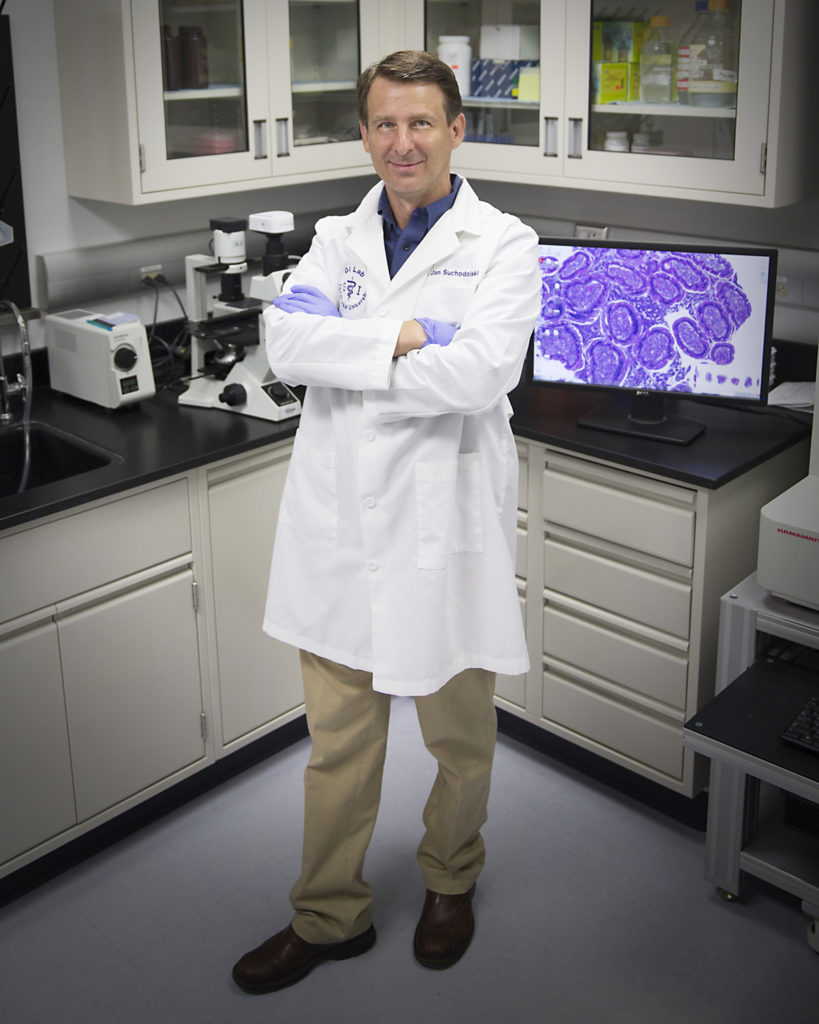Gut Instincts
Story by Corley-Ann Parker
Dr. Jan Suchodolski never intended to spend his career at Texas A&M, but while continuing his education at the Texas A&M College of Veterinary Medicine & Biomedical Sciences (CVM), he was introduced to a new and exciting discovery that changed the course of his career, placing him on the cutting-edge of microbiome research.

The research that Dr. Jan Suchodolski conducts at Texas A&M may be confirming the age-old trope that all of our pets are special—or at least their digestive systems are.
Suchodolski, an associate professor of gastroenterology in the College of Veterinary Medicine & Biomedical Sciences (CVM), and his associates are working to understand the microbiome of companion animals, or the collection of bacteria living in the digestive systems of cats and dogs.
While the microbiome has been thoroughly identified, there is still a lot of room for discovery.
“It’s a very complex field; we’re still at the beginning of characterizing all of the different bacterial types, and we still don’t have the best methods available,” Suchodolski said. “There are a trillion bacteria that are living in our gut; simply describing not only who they are but what they are doing, we are still trying to understand that.”
An Inside Look
Suchodolski‘s research works to expand this knowledge, including by looking at the effects of nutrition and treatments like antibiotics on this unique system.
“We understand the gut microbiota as a missing link; as we discover more and more about the microbiome, we’ve recognized it as part of our physiology,” Suchodolski said. “We have learned over the last few years that we have to see the host and microbiome as one unit. For example, there are some pathways that only microbiota take, and those benefit us. So, you cannot really see the microbiome as an external thing. It’s a part of the whole physiology.
“Ultimately, feeding and properly maintaining our gut microbiota is crucial; studies have shown that a lot of chronic diseases that we have examined are probably due to not taking care of our microbiota, meaning we don’t have the proper nutrition, we don’t have enough fiber, usually, in our diets,” he said. “The benefits of antibiotics in saving us from infectious diseases are huge, but we also realize that the side effect of antibiotics is diminishing the microbiota. So, we need to be aware of the importance of gut bacteria.”
Thinking of the microbiome as part of our physiology has opened the door to Suchodolski exploring the ways the microbiome is implicated in different disease types beyond the GI tract, just as it has in human medicine.
“A big area of research now is the gut-brain axis, because if we manipulate certain populations of gut bacteria we can affect cognition and behavior,” he said. “There is now a commercial probiotic available that reduces anxiety in dogs.”
Because of the many connections researchers have made between the microbiome of humans and animals, Suchodolski has also been able to examine procedures that have been successful in humans—such as fecal transplants—for animals.

“We have performed different studies, and noticed that the success rate differs for various diseases; we see in some diseases, especially acute or mild disease, a very high success rate, but in a chronic disease, the success is lower,” he said. “And it’s not just as simple as changing the gut’s bacteria; we’re discovering that it also depends on other things, like metabolic changes.”
The next step, Suchodolski said, is building predictive models that will help his team determine which cases will benefit from treatments such as fecal transplants.
“To build a predictive model, we have to determine what combinations of bacteria and their metabolites conjure the disease so you can predict better targets,” he said. “What we’ve discovered is that it’s not as simple as looking at the bacteria; we also need to look at what they’re doing. So, that’s our future goal.”
Developing A Symbiotic Relationship With The CVM
With so many cutting-edge projects, it seems that Suchodolski was born to do research; however, that wasn’t always his plan.
“I always wanted to be a veterinarian,” he said. “My career as a researcher was kind of a coincidence, but I simply love it. Every day there are new opportunities, new ideas, new exposures.”
Suchodolski came to Texas from Austria as a veterinary graduate to complete a short-term credit program; he had planned to return to Austria after his two years in Texas, but then he was offered the opportunity to complete a Ph.D.
He had begun studying abnormal bacterial populations in canine small intestines, but during his first year of his Ph.D. program, a paper looking at a new, molecular method for studying the microbiome was published; this discovery, had a significant impact on the field, and wanting to be a part of something new and exciting, he made the switch.
“That gave me the opportunity to develop this area because it was, back then, very novel,” Suchodolski said. “I was able to be a part of really building this field and pretty much become an expert in this area.”
After completing his doctorate, he decided to join the CVM faculty and hasn’t looked back. He said he is grateful for the opportunities that the CVM has allowed him and his research, which ultimately works to provide better, more individualized care to our pets.
“This a place that really has a culture of collaboration, of making things happen,” he said.
“It is because of our collaborations that we have earned international recognition; our lab is probably considered the most successful lab of its kind. This might not have been possible in other places but has happened here because A&M’s culture is very supportive.”
###
This story first appeared in the Fall 2019 edition of CVM Today.
For more information about the Texas A&M College of Veterinary Medicine & Biomedical Sciences, please visit our website at vetmed.tamu.edu or join us on Facebook, Instagram, and Twitter.
Contact Information: Jennifer Gauntt, Director of CVMBS Communications, Texas A&M College of Veterinary Medicine & Biomedical Sciences; jgauntt@cvm.tamu.edu; 979-862-4216



